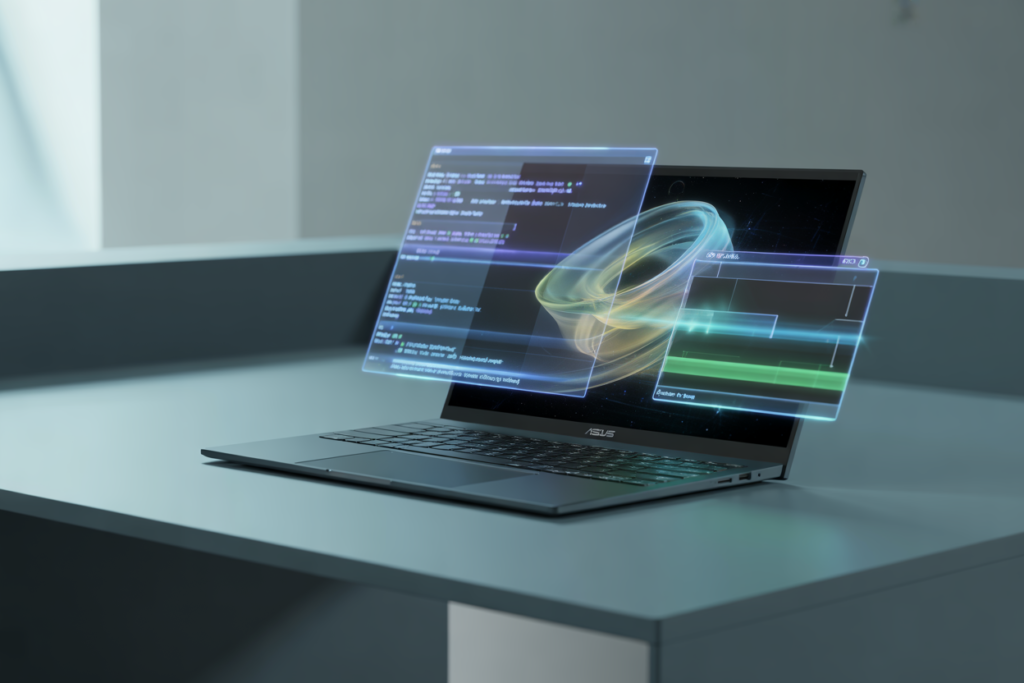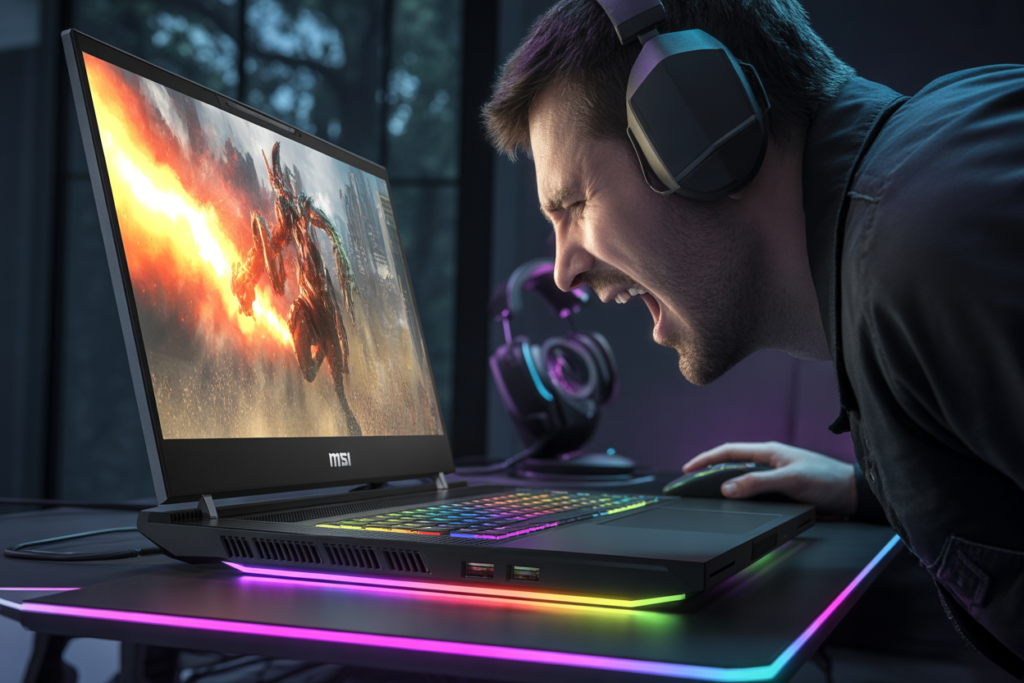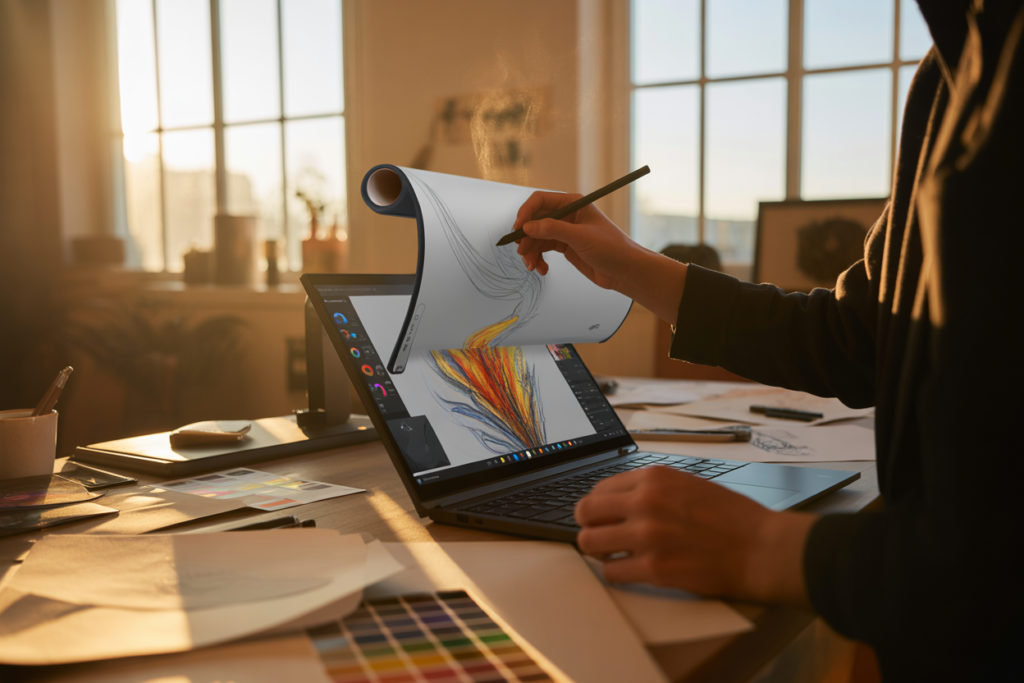The landscape of personal computing is undergoing a seismic shift as we delve into 2025, where next-gen laptops are no longer mere productivity tools but intelligent companions powered by artificial intelligence (AI), revolutionary processors, and sustainable designs. From the bustling show floors of CES 2025 to the labs of tech giants like Intel, AMD, and Qualcomm, innovations are blending cutting-edge hardware with seamless software ecosystems to deliver unprecedented performance, portability, and personalization. The global laptop market, valued at over $150 billion in 2024, is projected to grow at a compound annual growth rate (CAGR) of 8.5% through 2030, driven largely by AI integration and the demand for hybrid work solutions. Models like the ASUS Zenbook A14, Lenovo ThinkBook Plus Gen 6, and MSI Titan 18 HX are leading this charge, offering features that cater to gamers, professionals, and creators alike. This article explores the defining trends, advancements, and applications of next-gen laptops, shedding light on how they are reshaping our digital lives while addressing challenges like sustainability and accessibility. Whether you’re upgrading for work, play, or creativity, 2025’s laptops promise to elevate your experience to new heights.
The Fundamentals of Next-Gen Laptops
What Defines a Next-Gen Laptop?
At their core, next-gen laptops in 2025 are characterized by a trifecta of innovation: powerful, AI-optimized processors; high-efficiency batteries; and immersive displays. Unlike previous generations, these devices incorporate neural processing units (NPUs) for on-device AI tasks, enabling features like real-time language translation and predictive battery management. Processors such as Intel’s Core Ultra Series 2 (Lunar Lake), AMD’s Ryzen AI 300 series, and Qualcomm’s Snapdragon X Elite form the backbone, delivering up to 50% better performance and 40% improved GPU capabilities compared to 2024 models. Connectivity has evolved too, with standard Wi-Fi 7 support for ultra-low latency and 5G modems for untethered productivity. Sustainability is no afterthought; many incorporate recycled materials, like the Acer Aspire Vero 16’s 70% recycled plastic chassis, aligning with global ESG goals. These laptops aren’t just faster—they’re smarter, adapting to user habits through machine learning algorithms that optimize power usage and personalize interfaces.
The Evolution from Past Generations
The journey to 2025’s laptops began with the shift from Intel’s 12th-gen Alder Lake in 2021, which introduced hybrid cores, to the AI-centric Meteor Lake in 2023. By 2024, ARM-based chips like Snapdragon X challenged x86 dominance, paving the way for 2025’s Lunar Lake and Strix Halo processors, rumored to push efficiency boundaries with 100+ TOPS (trillions of operations per second) for AI workloads. Display tech has leaped from LCDs to ubiquitous OLED panels, now standard in 60% of premium models for vibrant colors and deep blacks. Battery life, once a sore point, now averages 20+ hours, thanks to low-power NPUs and advanced thermal management. This evolution reflects a broader trend: laptops are becoming “Copilot+ PCs,” Microsoft’s term for AI-ready devices that integrate generative tools like ChatGPT directly into the OS. From bulky gaming behemoths to featherweight ultrabooks, 2025 marks the maturation of portable powerhouses.
Major Advancements in Next-Gen Laptops
1. AI Integration and Processor Powerhouses
AI is the beating heart of 2025 laptops, with NPUs enabling on-device processing for privacy and speed. Intel’s Lunar Lake chips, featured in the ASUS Zenbook S 14, deliver 48 TOPS for AI tasks, powering features like real-time video call enhancements and automated note-taking. AMD’s Ryzen AI 300 series, seen in the MSI Raider 18 HX AI, boosts multitasking by 30%, ideal for creators rendering 4K videos. Qualcomm’s Snapdragon X2 Elite rumors suggest even greater efficiency, potentially extending battery life to 30 hours while handling complex AI models. These processors aren’t just faster; they’re predictive, learning user patterns to preload apps or suggest workflows.
Applications:
- Productivity Boosts: AI auto-summarizes meetings in Microsoft Teams.
- Creative Tools: Adobe Sensei integrates for seamless photo editing.
- Gaming: NVIDIA’s RTX 50-series GPUs, debuting in Razer Blade 16, use DLSS 4 for ray-traced 8K gaming at 120 FPS.

2. Display Innovations
Displays in 2025 laptops are a feast for the eyes, with OLED dominating 70% of new releases for infinite contrast and 100% DCI-P3 color accuracy. Lenovo’s ThinkBook Plus Gen 6 introduces a rollable OLED that expands from 14 to 16.7 inches, perfect for multitasking. Mini-LED backlighting in the MSI Titan 18 HX provides 2,000 nits brightness for HDR gaming, while variable refresh rates (1-240Hz) ensure smooth scrolling. Touchscreens with stylus support, like the Samsung Galaxy Book5 Pro’s 360-degree hinge, enable convertible modes for artists.
Impact:
- Immersive Experiences: 16-inch 4K OLEDs transform Netflix binges into cinema-quality sessions.
- Productivity: Rollable screens double workspace for coders.
- Eye Comfort: Anti-glare coatings and blue-light filters reduce strain during long sessions.
3. Battery and Efficiency Breakthroughs
Gone are the days of frantic charger hunts; 2025 laptops boast 20-30 hour batteries thanks to efficient ARM architectures and silicon-carbon anodes. The Apple MacBook Pro 2025 with M5 chip promises 50% better efficiency, hitting 28 hours of mixed use. Fast charging—80% in 30 minutes—is standard, powered by USB-C/Thunderbolt 5 ports supporting 240W delivery. AI optimizes power by dimming unused cores, extending life during video calls.
Applications:
- Remote Work: All-day unplugged sessions for digital nomads.
- Travel: Solar-assisted charging in models like the Acer Aspire Vero 16 for eco-conscious users.
- Gaming: Sustained performance without thermal throttling.
Case Study: The ASUS ROG Zephyrus G15 2025, with AMD Ryzen 8000 and RTX 5070, lasts 12 hours on light loads, a 40% improvement over 2024.
4. Design and Portability
Slimmer is better: 2025 laptops average under 1.2kg, with the Zenbook A14 at 980g using magnesium alloy. Foldable and dual-screen designs, like the Lenovo Yoga Slim 9i, offer versatility for creatives. Sustainability shines in the Acer Aspire Vero 16’s recycled build, reducing carbon footprints by 30%. RGB keyboards and customizable chassis, as in Razer’s Blade 17, add flair without bulk.
5. Connectivity and Peripherals
Wi-Fi 7 and Thunderbolt 5 dominate, with 5G modems in 40% of premium models for global roaming. Ports include dual USB4 for 8K external displays, and UWB for precise device pairing. Security features like Microsoft’s Pluton chip protect data at the hardware level.
Applications:
- Hybrid Work: Seamless docking to monitors.
- Gaming: Low-latency multiplayer under 1ms.
- Security: Biometric logins under advanced encryption.
6. Gaming and Creative Enhancements
Gaming laptops like the MSI Titan 18 HX pack RTX 5090 GPUs for 4K ray tracing. Creative pros benefit from color-accurate OLEDs and 32GB RAM in the MacBook Pro 2025. AI upscaling in NVIDIA Studio drivers accelerates rendering by 50%.

Applications of Next-Gen Laptops
1. Professional Productivity
For remote workers, the Lenovo ThinkPad X9’s rollable display enables dual-app viewing, boosting efficiency by 35%. AI tools in Windows 11 Copilot+ PCs automate spreadsheets and emails.
2. Creative Workflows
The MacBook Pro 2025’s M5 chip handles 8K video edits fluidly, while stylus support in Samsung Galaxy Book5 Pro aids digital artists. Adobe integrations leverage NPUs for instant effects.
3. Gaming and Entertainment
RTX 50-series laptops like Razer’s Blade 16 deliver portable esports, with 240Hz OLEDs for tear-free play. Netflix and streaming apps benefit from AI-enhanced upscaling.
4. Education and Accessibility
Affordable models like the Acer Swift Go 16 offer OLED for immersive learning, with AI subtitles for lectures. Voice controls and large fonts enhance inclusivity.

5. Sustainability and Remote Travel
Eco-laptops like Acer Vero reduce e-waste, while 5G ensures connectivity on the go. Solar hints in prototypes promise off-grid use.
Challenges in Next-Gen Laptops
1. Cost and Accessibility
Premium features inflate prices to $1,500+, limiting access for students. Budget options lag in AI capabilities.
2. Thermal Management
High-power GPUs generate heat; advanced cooling like vapor chambers mitigates but adds weight.
3. Compatibility and Ecosystem Lock-in
ARM chips face x86 app issues, while iOS integration favors Apple. Cross-platform standards are evolving.
4. Environmental Impact
While sustainable, mining rare earths for batteries persists; recycling rates must improve.
The Future of Next-Gen Laptops
1. Quantum and Neuromorphic Computing
By 2030, quantum-assisted processors could solve complex simulations instantly. Neuromorphic chips mimic brains for ultra-efficient AI.
2. Foldable and Modular Designs
Tri-fold screens and swappable modules for upgrades will dominate.
3. 6G and AR Integration
6G will enable holographic collaborations, blending laptops with AR glasses.
Prediction: By 2030, AI laptops will comprise 80% of sales, adding $1 trillion to global productivity, per Gartner adaptations.
Societal Implications
Next-gen laptops democratize AI, empowering remote education in underserved areas but risk widening divides without affordable options. They drive sustainability through efficient designs, reducing energy use by 20%, yet e-waste demands better recycling. Ethically, on-device AI enhances privacy but requires transparent algorithms to prevent bias.
Conclusion
2025’s next-gen laptops, from AI-driven Zenbooks to rollable ThinkBooks, herald an era of intelligent, efficient computing. Advancements in processors, displays, and batteries are making these devices indispensable for work, play, and creation. Challenges like cost persist, but the trajectory points to a future of seamless, sustainable tech. As CES 2025’s innovations unfold, one thing is clear: the laptop is evolving into your ultimate digital ally.
Leave a Reply